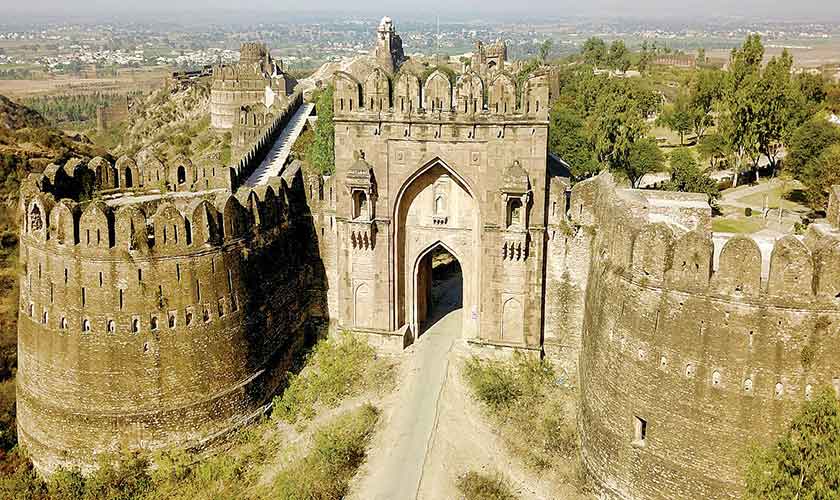[ad_1]
Visiting the Majestic Rohtas Fort
Rohtas Fort, a UNESCO World Heritage Site, is a magnificent fortress located near the city of Jhelum in Pakistan’s Punjab province. With its awe-inspiring architecture and historical significance, a visit to this majestic fort is like stepping back in time. Let’s dive into the highlights of this iconic landmark and explore the wonders it has to offer.
History
Construction of Rohtas Fort began in 1541 by Sher Shah Suri, the Afghan king who ruled vast parts of northern India and Pakistan. This imposing fortress was built to consolidate Sher Shah’s hold over the region and to serve as a stronghold against potential rebellions and invasions. Despite changing hands several times after Sher Shah’s death, the fort remained intact, preserving its historical significance for centuries.
Architectural Marvel
The architecture of Rohtas Fort is a fusion of Afghan, Hindu, and Islamic styles, making it a unique masterpiece. The fort is spread over an area of 70 acres and is surrounded by tall, imposing walls that are up to 12.9 meters thick and 18.3 meters high. These walls are punctuated with several gateways, including the Sohail and Langar Khani gates, each adorned with intricately designed motifs and calligraphy.
Walking through the fort, one can marvel at the blend of sturdy and delicate architectural elements. The Haveli Man Singh, a stunning palace inside the fort, showcases the beautiful craftsmanship of the Mughal era. Its decorative balconies, intricately carved pillars, and ornate jharokas (overhanging enclosed balconies) are a sight to behold.
Breathtaking Surroundings
Rohtas Fort is surrounded by picturesque landscapes that enhance its charm. The fort overlooks the river Kahan, and its location at the foothills of the picturesque Potohar Plateau provides a stunning backdrop against the majestic Himalayan range. Visitors can take a leisurely stroll around the fort, capturing the scenic beauty and immersing themselves in the serenity of the surroundings.
Exploring the Fort
As you enter Rohtas Fort, you will be transported to an era of valor and grandeur. The fort presents numerous attractions and sections to be explored, each with its own unique significance.
Rohtas Gallery
The Rohtas Gallery is a museum located within the fort premises that exhibits a collection of artifacts, including ancient weapons, pottery, and paintings. Visitors can delve into the rich history of the region and gain deeper insights into the fort’s significance.
Shahi Mosque
The Shahi Mosque, built during Emperor Akbar’s reign, is a magnificent structure located inside the fort. Its grandeur lies in its architectural intricacies and the beauty of its craftsmanship. This mosque is still in use today and showcases the religious importance of the fort.
Birrah Khan’s Toilets
A fascinating feature of Rohtas Fort is Birrah Khan’s Toilets, a system of interconnected underground chambers built for the purpose of bathing and sanitation. This unique architectural marvel is an engineering feat of its time, highlighting the advanced infrastructure planning employed in the fort’s construction.
Haveli Man Singh
Haveli Man Singh, the grand palace inside the fort, is a testament to the opulence of the Mughal era. Its ornate interiors and breathtaking views from the balconies make it a must-visit attraction within Rohtas Fort.
Stepwell ‘Talaqi’
The stepwell, locally known as ‘Talaqi,’ is a striking feature of the fort. This well was built to provide a consistent water supply to the residents of the fort and showcases the innovative engineering skills of the time.
Preserving Heritage
Rohtas Fort, with its historical importance and architectural brilliance, has been remarkably well-preserved. Its stone structures, intricate carvings, and remnants of the past stand as a testament to the rich heritage of the region. The fort’s inclusion on the UNESCO World Heritage List has further emphasized the need to protect and conserve this treasure.
Efforts are underway to ensure that Rohtas Fort remains a globally recognized monument. Government bodies, along with local communities and international organizations, are working together to conduct restoration and conservation projects. These initiatives aim to maintain the fort’s grandeur while also creating opportunities for cultural exchange and tourism.
Plan Your Visit
Rohtas Fort is easily accessible by road from major cities in Punjab, including Islamabad, Lahore, and Rawalpindi. The ideal time to visit is during the winter months of November to February when the weather is pleasant and favorable for exploring the fort and its surroundings.
Before setting off on your adventure, ensure that you have enough time to fully experience the magnificence of Rohtas Fort. Guided tours are available for visitors who want to gain a deeper understanding of its historical significance.
When visiting the fort, wear comfortable clothing and shoes as you will be doing a fair amount of walking. Carry a bottle of water and some snacks to keep yourself energized throughout the day. Don’t forget your camera to capture the stunning views and timeless beauty of the fort.
Conclusion
A visit to Rohtas Fort is a journey through time, offering a glimpse into the rich history and awe-inspiring architecture of the region. From its imposing walls and gateways to its stunning palace and underground chambers, every corner of the fort tells a tale of grandeur and valor. As you explore the fort and its surrounding landscapes, you will undoubtedly be mesmerized by its breathtaking beauty and the feeling of stepping back in time. Rohtas Fort is truly a must-visit destination for history enthusiasts, architecture aficionados, and anyone seeking to immerse themselves in the rich cultural heritage of Pakistan.
[ad_2]

